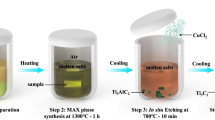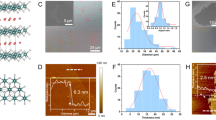Abstract
The large class of layered ceramics encompasses both van der Waals (vdW) and non-vdW solids. While intercalation of noble metals in vdW solids is known, formation of compounds by incorporation of noble-metal layers in non-vdW layered solids is largely unexplored. Here, we show formation of Ti3AuC2 and Ti3Au2C2 phases with up to 31% lattice swelling by a substitutional solid-state reaction of Au into Ti3SiC2 single-crystal thin films with simultaneous out-diffusion of Si. Ti3IrC2 is subsequently produced by a substitution reaction of Ir for Au in Ti3Au2C2. These phases form Ohmic electrical contacts to SiC and remain stable after 1,000 h of ageing at 600 °C in air. The present results, by combined analytical electron microscopy and ab initio calculations, open avenues for processing of noble-metal-containing layered ceramics that have not been synthesized from elemental sources, along with tunable properties such as stable electrical contacts for high-temperature power electronics or gas sensors.
This is a preview of subscription content, access via your institution
Access options
Access Nature and 54 other Nature Portfolio journals
Get Nature+, our best-value online-access subscription
$29.99 / 30 days
cancel any time
Subscribe to this journal
Receive 12 print issues and online access
$259.00 per year
only $21.58 per issue
Buy this article
- Purchase on Springer Link
- Instant access to full article PDF
Prices may be subject to local taxes which are calculated during checkout




Similar content being viewed by others
References
Barsoum, M. W. & Radovic, M. Elastic and mechanical properties of the MAX phases. Annu. Rev. Mater. Res. 41, 195–227 (2011).
Eklund, P., Beckers, M., Jansson, U., Högberg, H. & Hultman, L. The Mn+1AXn phases: materials science and thin-film processing. Thin Solid Films 518, 1851–1878 (2010).
Naguib, M., Mochalin, V. N., Barsoum, M. W. & Gogotsi, Y. 25th anniversary article: MXenes: a new family of two-dimensional materials. Adv. Mater. 26, 992–1005 (2014).
Naguib, M. et al. Two-dimensional nanocrystals produced by exfoliation of Ti3AlC2 . Adv. Mater. 23, 4248–4253 (2011).
Halim, J. et al. Synthesis and characterization of 2D molybdenum carbide (MXene). Adv. Funct. Mater. 26, 3118–3127 (2016).
Dillon, A. D. et al. Highly conductive optical quality solution-processed films of 2D titanium carbide. Adv. Funct. Mater. 26, 3118–3127 (2016).
Urbankowski, P. et al. Synthesis of two-dimensional titanium nitride Ti4N3 (MXene). Nanoscale 8, 11385–11391 (2016).
Zhou, J. et al. A two-dimensional zirconium carbide by selective etching of Al3C3 from nanolaminated Zr3Al3C5 . Angew. Chem. Int. Ed. 55, 5008–5013 (2016).
Ghidiu, M., Lukatskaya, M. R., Zhao, M.-Q., Gogotsi, Y. & Barsoum, M. W. Conductive two-dimensional titanium carbide ‘clay’ with high volumetric capacitance. Nature 516, 78–81 (2014).
Ling, Z. et al. Flexible and conductive MXene films and nanocomposites with high capacitance. Proc. Natl Acad. Sci. USA 111, 16676–16681 (2014).
Lukatskaya, M. R. et al. Cation intercalation and high volumetric capacitance of two-dimensional titanium carbide. Science 341, 1502–1505 (2013).
Mashtalir, O. et al. Intercalation and delamination of layered carbides and carbonitrides. Nat. Commun. 4, 1716 (2013).
Wang, Z., Liu, W. & Wang, C. Recent progress in Ohmic contacts to silicon carbide for high-temperature applications. J. Electron. Mater. 45, 267–284 (2016).
Fashandi, H. et al. Single-step synthesis process of Ti3SiC2 Ohmic contacts on 4H–SiC by sputter-deposition of Ti. Scr. Mater. 99, 53–56 (2015).
Lai, C.-C. et al. Structural and chemical determination of the new nanolaminated carbide Mo2Ga2C from first principles and materials analysis. Acta Mater. 99, 157–164 (2015).
Hu, C. et al. Mo2Ga2C: a new ternary nanolaminated carbide. Chem. Commun. 51, 6560–6563 (2015).
Koski, K. J. et al. High-density chemical intercalation of zero-valent copper into Bi2Se3 nanoribbons. J. Am. Chem. Soc. 134, 7584–7587 (2012).
Yao, J. et al. Optical transmission enhancement through chemically tuned two-dimensional bismuth chalcogenide nanoplates. Nat. Commun. 5, 5670 (2014).
Motter, J. P., Koski, K. J. & Cui, Y. General strategy for zero-valent intercalation into two-dimensional layered nanomaterials. Chem. Mater. 26, 2313–2317 (2014).
Trupina, L. et al. Iridium layer as oxygen barrier and growth substrate for oriented PZT thin films. J. Optoelectron. Adv. M. 9, 1508–1510 (2007).
Tu, K. N. Selective growth of metal-rich silicide of near-noble metals. Appl. Phys. Lett. 27, 221–224 (1975).
Hiraki, A. Formation of silicon oxide over gold layers on silicon substrates. J. Appl. Phys. 43, 3643 (1972).
Lee, S., Stephens, J. A. & Hwang, G. S. On the nature and origin of Si surface segregation in amorphous AuSi alloys. J. Phys. Chem. C 114, 3037–3041 (2010).
in Hg-Ho–La-Zr Vol. G (ed. Madelung, O.) (Landolt-Börnstein - Group IV Physical Chemistry, Springer, 1997).
in Ac-Au–Au-Zr Vol. A (ed. Madelung, O.) (Landolt-Börnstein - Group IV Physical Chemistry, Springer, 1991).
Ruban, A. V., Skriver, H. L. & No, J. K. Surface segregation energies in transition-metal alloys. 59, 990–1000 (1999).
Hedayati, R., Lanni, L., Rusu, A. & Zetterling, C.-M. Wide temperature range integrated bandgap voltage references in 4H–SiC. IEEE Electron Device Lett. 37, 146–149 (2016).
Wijesundara, M. & Azevedo, R. Silicon Carbide Microsystems for Harsh Environments (Springer, 2011).
Andersson, M., Pearce, R. & Lloyd, S. A. New generation SiC based field effect transistor gas sensors. Sensors Actuators B 179, 95–106 (2013).
Daves, W., Krauss, A., Haublein, V., Bauer, A. J. & Frey, L. Structural and reliability analysis of Ohmic contacts to SiC with a stable protective coating for harsh environment applications. ECS J. Solid State Sci. Technol. 1, P23–P29 (2012).
Virshup, A. et al. Investigation of thermal stability and degradation mechanisms in Ni-based Ohmic contacts to n-type SiC for high-temperature gas sensors. J. Electron. Mater. 38, 569–573 (2009).
Acknowledgements
We acknowledge H. Pedersen for useful discussions about the results. We acknowledge the support from the VINN Excellence Center in research and innovation on Functional Nanoscale Materials (FunMat) by the Swedish Governmental Agency for Innovation Systems (VINNOVA) and the Swedish Government Strategic Research Areas in Materials Science on Functional Materials at Linköping University (Faculty Grant SFO-Mat-LiU No. 2009 00971). P.E., J.L., M.D. and J.R. also acknowledge support from the Swedish Foundation for Strategic Research through the Future Research Leaders 5 Program and the Synergy Grant FUNCASE, Functional Carbides and Advanced Surface Engineering. I.A.A. is grateful for support provided by the e-Science Research Centre (SeRC). S.I.S. acknowledges Swedish Research Council (VR) Project No. 2014-4750. P.E. also acknowledges support from the European Research Council under the European Community’s Seventh Framework Programme (FP/2007-2013)/ERC grant agreement no. 335383. L.H. acknowledges the Knut and Alice Wallenberg Foundation for a Scholar Grant and support for the Linköping Ultra Electron Microscopy Laboratory. The calculations were performed on resources provided by the Swedish National Infrastructure for Computing (SNIC) at National Supercomputer Centre (NSC) and PDC.
Author information
Authors and Affiliations
Contributions
H.F., M.A., A.L.S. and P.E. conceived and initiated the work. H.F. conducted and analysed the growth, annealing, XRD and SEM. M.D. performed the ab initio studies with input from S.I.S., I.A.A., J.R., H.F. and P.E. J.L. conducted the STEM and EDX and analysed the results with contributions from H.F., L.H. and P.E. J.P. designed, executed, and interpreted the in situ annealing in TEM, and recorded the movie. H.F., M.D. and P.E. wrote the manuscript with contributions from the other coauthors. All coauthors read and commented on successive drafts of the manuscript. M.A., A.L.S. and P.E. supervised the work.
Corresponding authors
Ethics declarations
Competing interests
The authors declare no competing financial interests.
Supplementary information
Supplementary Information
Supplementary Information (PDF 3307 kb)
Supplementary Movie
Supplementary Movie (MP4 40109 kb)
Rights and permissions
About this article
Cite this article
Fashandi, H., Dahlqvist, M., Lu, J. et al. Synthesis of Ti3AuC2, Ti3Au2C2 and Ti3IrC2 by noble metal substitution reaction in Ti3SiC2 for high-temperature-stable Ohmic contacts to SiC. Nature Mater 16, 814–818 (2017). https://doi.org/10.1038/nmat4896
Received:
Accepted:
Published:
Issue Date:
DOI: https://doi.org/10.1038/nmat4896
This article is cited by
-
Synthesis of single-atom-thick gold layers
Nature Synthesis (2024)
-
Synthesis of goldene comprising single-atom layer gold
Nature Synthesis (2024)
-
Key role of electron accessibility at the noble metal-free catalytic interface in hydrogen evolution reaction
Nano Research (2024)
-
Applications of MXenes in human-like sensors and actuators
Nano Research (2023)
-
Synthesis of rare-earth metal compounds through enhanced reactivity of alkali halides at high pressures
Communications Chemistry (2022)



